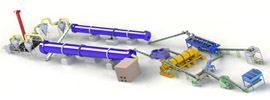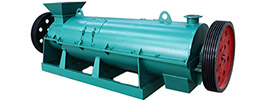I. Working Principle
1. Structural Components
- Tank Body: A horizontally placed cylindrical container equipped with an agitation system (spiral blades or paddles) and an aeration system (air vents at the bottom or sides).
- Temperature Control System: Sensors combined with heating/cooling devices to maintain fermentation temperatures between 50~65°C (mid-stage high temperatures reach 55~65°C to eliminate pathogens).
- Exhaust System: Removes fermentation byproducts like CO₂ and water vapor.
- Drive Mechanism: Motor-driven agitation system ensuring continuous material movement.
- Insulation Layer: Polyurethane material minimizes heat loss.
- Gas Treatment Unit: Deodorization system reduces odor and greenhouse gas emissions.
2. Fermentation Process
- Aerobic Fermentation:
- Inoculated with fermentation strains (e.g., Bacillus, Actinomycetes) in oxygen-rich conditions to decompose organic matter, generating heat, CO₂, and water.
- Temperature Regulation:
- Initial Stage: Heating to 40~50°C to activate microbial activity.
- Mid-Stage: Thermophilic phase (55~65°C) for pathogen/weed seed inactivation.
- Final Stage: Cooling for maturation and stabilization.
- Oxygen Supply: Forced ventilation or agitation prevents anaerobic conditions, enhancing efficiency.
- Continuous Agitation: Rotating blades ensure uniform mixing, prevent caking, and shorten cycles (7~15 days vs. 30+ days for traditional composting).
- Automated Control: Real-time monitoring of temperature, humidity, and O₂ levels adjusts ventilation and agitation dynamically.
3. Microbial Functions
- Fermentation Strains: Decompose organic matter (e.g., Bacillus, Actinomycetes) and generate metabolic heat.
- Beneficial Microbes: Enhance soil structure, promote crop growth, and suppress pathogens.
II. Core Advantages
1. High Efficiency
- Rapid Fermentation: Cycles reduced to 7~15 days (5~10× faster than traditional methods).
- Automation: Single operator manages full workflow, lowering labor costs.
2. Environmental Benefits
- Emission Control: Bio-deodorization systems meet regulatory standards, reducing odors and greenhouse gases.
- Closed Design: Minimizes heat loss, cutting energy use by >30%.
3. Versatility
- Broad Material Compatibility: Processes livestock manure (poultry, swine), agricultural waste (straw, produce residues), and municipal sludge.
- High-Moisture Handling: Accepts 60~70% moisture content; adjusts C/N ratio with additives (straw, sawdust).
4. Space Optimization
- Compact Layout: Horizontal design suits factory-scale continuous production, reducing facility height requirements.
5. Product Quality
- Sanitization: Thermophilic phase eliminates pathogens/weed seeds, yielding compliant organic fertilizer.
- Nutrient-Rich Output: Contains organic matter, N/P/K, and micronutrients; improves soil health and crop yields.
6. Economic Value
- Low Energy Consumption: Closed-loop design reduces thermal loss, outperforming trough fermentation in efficiency.
- Durable Construction: 304 stainless steel/glass-reinforced plastic ensures 10~15-year lifespan with minimal maintenance.
III. Applications
- Livestock Waste Treatment: Rapid maturation of poultry/swine manure.
- Agricultural Residue Recycling: Straw/produce waste conversion.
- Municipal Sludge Management: Co-fermentation with organic waste for fertilizer production.
- Industrial-Scale Production: Factory-based continuous output for large-scale organic fertilizer demand.
IV. Conclusion
The horizontal organic fertilizer fermentation tank integrates mechanical agitation, forced aeration, and precision temperature control to achieve efficient, eco-friendly organic waste treatment. Its advantages—rapid cycles, automation, low energy use, broad adaptability, and high-quality output—make it an ideal solution for modern organic fertilizer production.
 Send us a Email
Send us a Email Wulong Industrial Cluster
Wulong Industrial Cluster Have any question?
Have any question?



















